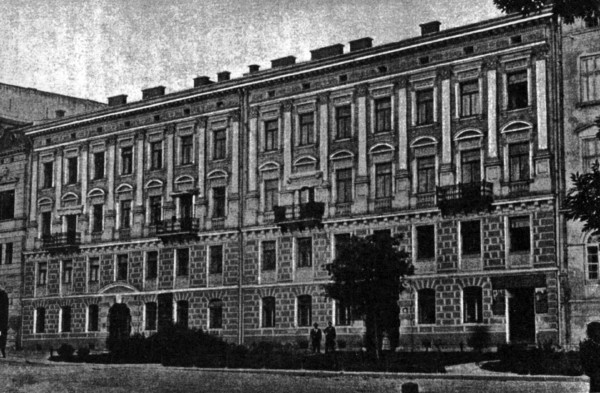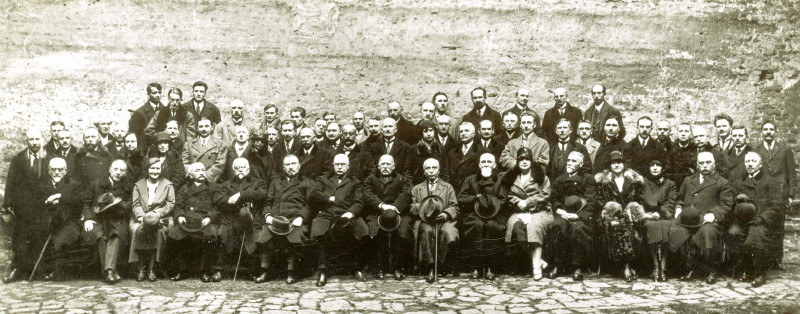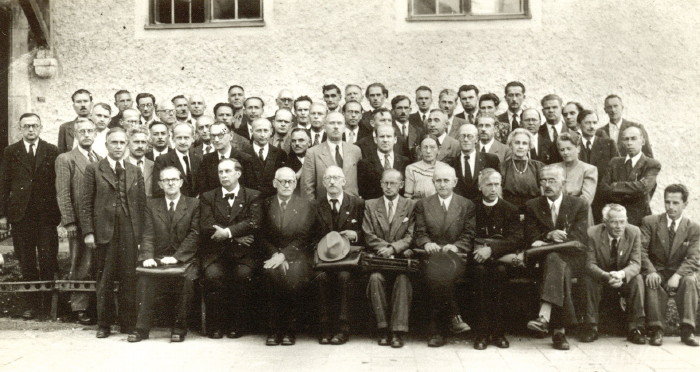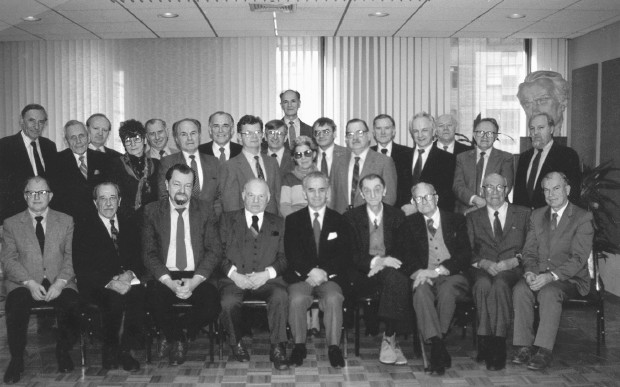Shevchenko Scientific Society
Shevchenko Scientific Society [Наукове товариство ім. Шевченка; Naukove tovarystvo im. Shevchenka, or НТШ; NTSh]. The oldest, and for a long time the only, prominent Ukrainian scholarly society. It was founded on 11 December 1873 in Austrian-ruled Lviv as the Shevchenko Society (Tovarystvo im. Shevchenka) with the aim of fostering the development of Ukrainian literature. The society’s initiators were leading Ukrainian community and cultural figures on both sides of the Austrian-Russian border, headed by Oleksander Konysky. Its benefactors included Yelysaveta Myloradovych, Dmytro Pylchykov, Mykhailo Zhuchenko, and Rev Stepan Kachala. The Shevchenko Society’s first act was the purchase of a printing press and the establishment of its own publishing house in 1874. By 1891 it had published 20 books, including Omelian Ohonovsky’s pioneering three-volume history of Ukrainian literature and the periodicals: the journal Pravda (1878–9) and Zoria (Lviv) (from 1885). The society’s first presidents were Kornylo Sushkevych (1874–85), Sydir Hromnytsky (1885–6, 1887–90), Demian Hladylovych (1886–7, 1890–2), and Yuliian Tselevych (1892).
1893–1914. Because the publication of Ukrainian literature and scholarship in Russian-ruled Ukraine was severely restricted after the imposition of the 1876 Ems Ukase and subsequent tsarist edicts, in 1893 the Shevchenko Society was reorganized on the initiative of Oleksander Konysky and Volodymyr Antonovych ‘to foster and develop science and art in the Ukrainian-Ruthenian language [and] to preserve and collect ... the monuments of antiquity [and] the scientific objects of Ukraine-Rus'.’ Renamed the Shevchenko Scientific Society and modeled on Western European scientific institutions, the NTSh pursued the aim of becoming ‘the progenitor of a future Ukrainian-Ruthenian academy of sciences.’ Under the leadership of Oleksander Barvinsky (1893–7) a library (70,000 cataloged volumes and 500 manuscripts in 1914—the fullest and most systematic collection of Ucrainica in the world), museum (15,047 artifacts in 1920), and bookstore were established in Lviv. The NTSh's 137 members were divided among three sections—Philological (directed by Omelian Ohonovsky), Historical-Philosophical (Anatol Vakhnianyn), and Mathematical–Natural Sciences–Medical (Ivan Verkhratsky).
The NTSh acquired a pan-Ukrainian importance and scholarly prestige under the presidency (1897–1913) of Mykhailo Hrushevsky, who was also director of the Historical-Philosophical Section from 1894. Assisted by Volodymyr Hnatiuk as NTSh secretary (1898–1926) and head of the Ethnographic Commission of the Shevchenko Scientific Society, and Ivan Franko as director (1898–1908) of the Philological Section, Hrushevsky turned the NTSh into a de facto academy of sciences to which virtually all Ukrainian scholars belonged. On his suggestion, in 1899 the NTSh was divided into 32 prominent full members, who represented the sections, and many regular members, who could not vote on scholarly matters at section meetings. As a result Lviv acquired the status of a Ukrainian cultural and scholarly capital. Seminars were created within the various NTSh commissions and other bodies, and younger scholars were gainfully employed, the NTSh thereby being given a quasi-university function. Under Hrushevsky and Franko the Historical-Philosophical and Philological sections grouped together all the major Ukrainian historians and philologists. Contacts with foreign learned institutions were established by the participation of NTSh members in international congresses and conferences, and by an exchange of publications with nearly 250 foreign institutions.
The primary NTSh organ, Zapysky Naukovoho tovarystva im. Shevchenka (est 1892), became a quarterly (1895) and then a bimonthly (1896) under Mykhailo Hrushevsky’s editorship (1895–1913). A second periodical, the quarterly Khronika NTSh, was founded in 1900 to provide information about NTSh activities. Pioneering and fundamental research was also published in the NTSh Legal Commission's Chasopys’ pravnycha (from 1893); the Archeographic Commission’s Zherela do istoriï Ukraïny-Rusy (from 1895) and Pam'iatky ukraïns’ko-rus’koï movy i literatury (from 1896); the Ethnographic Commission’s Etnohrafichnyi zbirnyk (from 1895) and Materiialy do ukraïns’koï etnolohiï (from 1899); the Mathematical–Natural Science–Medical Section’s series Zbirnyk Matematychno-pryrodopysno-likars’koï sektsiï NTSh (from 1897); the Historical-Philosophical Section's series Rus’ka istorychna biblioteka (from 1894) and Zbirnyk Istorychno-filosofichnoï sektsiï NTSh (from 1898), and an annual monograph series, Ukraïns’ko-rus’kyi arkhiv (from 1905); the Philological Section’s series Zbirnyk Filolohichnoï sektsiï NTSh (from 1898); and the Bibliographic Commission’s Materiialy do ukraïns’koï bibliohrafiï (from 1909). In addition the NTSh published the Ukrainska biblioteka series of annotated Ukrainian literary classics (24 vols, 1901–4) and the prominent cultural-political monthly Literaturno-naukovyi vistnyk (1898–1906).
Changes occurred in the NTSh's role and scope after tsarist restrictions on Ukrainian writing and scholarship were lifted in the wake of the Revolution of 1905. The Ukrainian Scientific Society in Kyiv (est 1907), for example, took over publication of Literaturno-naukovyi vistnyk. Nonetheless, the NTSh retained its importance in the Ukrainian scholarly world, even after Mykhailo Hrushevsky resigned as president in 1913 and his functions were assumed by the vice-president, Stepan Tomashivsky (1913–18).
1915–44. The First World War interrupted all NTSh activities, including plans to transform the NTSh into an academy of sciences in 1916. During the occupation of Galicia in 1914–15, the NTSh was outlawed, and its buildings and presses were confiscated. Many of its members died at the front or were civilian casualties, and many of its valuable library, archival, and museum holdings and scholarly acquisitions, as well as its student residence, were destroyed.
The NTSh was revived during the interwar Polish occupation of Western Ukraine, but it functioned on a lesser scale. Many of its members became political émigrés in the West, some emigrated to Soviet Ukraine, and the influx of new scholarly cadres declined (in 1923 the NTSh had 106 full members, 30 of them foreign scholars). Polish interference and taxation, the slashing of government subsidies, the withdrawal of rights to print schoolbooks, and the confiscation of most Ukrainian-American and Soviet Ukrainian publications addressed to its library also impinged on the NTSh's activities, income, and ability to publish. With the establishment of the All-Ukrainian Academy of Sciences (VUAN) in Kyiv and Ukrainian scholarly institutions in Poland and Bohemia in the 1920s, the NTSh was no longer the primary Ukrainian scholarly center.
The NTSh continued its activities under the presidency of Vasyl Shchurat (1919–25), Kyrylo Studynsky (1925–31), Volodymyr O. Levytsky (1931–5), and Ivan A. Rakovsky (1935–49). The NTSh Museum’s collections were divided up to form the new NTSh museums of Culture and History (1920, with departments of archeology, ethnography, art, numismatics, and historical monuments [75,000 artifacts in 1927]), Natural Science (1920; now Natural Science Museum of the National Academy of Sciences of Ukraine), and the Ukrainian Military (1937). The NTSh Library was rebuilt and expanded (over 300,000 volumes in 1939) under the directors Ivan Krevetsky and Volodymyr Doroshenko. In 1921 the Institute of Normal and Pathological Psychology (directed by Stepan Balei) and the Bacteriological-Chemical Institute (directed by Maksym Muzyka) were created as part of the NTSh. In the early 1920s the NTSh organized the Lviv (Underground) Ukrainian University and Lviv (Underground) Ukrainian Higher Polytechnical School. It established relations with the VUAN in Kyiv and co-operated with it in many matters, particularly orthography. An outstanding example of such collaboration was a Ukrainian mathematical dictionary (1926), which was prepared jointly by the academy’s Institute of the Ukrainian Scientific Language and the NTSh. The NTSh's three scholarly sections and Legal, Statistical, Classic Philology, Linguistic, Archeological, Ethnographic, Art History, Physiographic, Bibliographic, and Publishing commissions remained active. The Shevchenko Studies Commission, with its own Serial, Terminological, Scientific-Technical, and Scientific-Agronomical commissions, and two other journals, Stara Ukraïna (1924–5) and S’ohochasne i mynule (1939), were established. In the 1930s the NTSh sponsored the preparation of an atlas of Ukraine (edited by Volodymyr Kubijovyč) and copublished the serials Ukraïns’ka knyha, Ukraïns’ka muzyka, and Likars’kyi vistnyk. With the Stalinist suppression of Soviet Ukrainian culture in the 1930s, the NTSh partly regained its earlier status in the Ukrainian scholarly world. Its international prestige remained high, as attested by the acceptance of membership in the NTSh by Max Planck (in 1923), David Hilbert (in 1924), and Albert Einstein (in 1929).
From its founding in 1873 until 1939 the NTSh issued 591 serial volumes (including 155 volumes of Zapysky Naukovoho tovarystva im. Shevchenka, 121 of them in 1891–1914), 352 individual scholarly publications, textbooks, and maps, 103 books of literary journalism, 95 belletristic works, and 31 informational publications.
During the first Soviet occupation of Galicia (1939–41) the NTSh was shut down. In 1940 it was forced by the Soviet authorities to dissolve, and its properties were expropriated by the state. Many of its members disappeared or were repressed, and others fled to German-occupied Poland. During the German occupation of Galicia (1941–4) the Nazi regime did not allow the NTSh to be publicly active. Before the Soviet reoccupation of Lviv in 1944, most remaining NTSh members fled to the West.
After 1947. On the initiative of Volodymyr Kubijovyč and Ivan A. Rakovsky, the NTSh was revived in Munich in June 1947 by members who had sought refuge in postwar Germany. Rakovsky was re-elected president (1947–9) and was succeeded by Zenon Kuzelia (1949–52); Kubijovyč was elected general secretary. New full members, particularly postwar émigré scholars from Soviet Ukraine, were elected, and the sections and several commissions resumed their work. New Nationality Research, Encyclopedia, Bibliological, and Ukrainian Language institutes were established, and the journal S’ohochasne i mynule (1948–9) was revived. After the mass emigration of Ukrainian refugees from Germany and Austria to countries of the New World in 1947–9, chapters of the NTSh were established in the United States (1947), Canada (1949), and Australia (1950). In 1951 the NTSh executive center, library, and archives were transferred from Munich to Sarcelles, near Paris. In 1952 the American chapter purchased its own building in New York and established a library and archives there.
In 1953 the NTSh had 126 full members and 226 regular members; in 1964 it had 139 full members and 485 regular members, over half of them in the United States. In 1955 the European, American, Canadian, and Australian chapters became autonomous NTSh societies, headed by Volodymyr Kubijovyč, Volodymyr Yaniv, Arkadii Zhukovsky, and Danylo Husar Struk in Sarcelles, by Mykola Chubaty, Roman Smal-Stotsky, Matvii Stakhiv, Osyp Andrushkiv, Yaroslav Padokh, Leo Rudnytzky, Larissa Onyshkevych, and George Grabowicz in New York, by Yevhen Vertyporokh, Bohdan Stebelsky, Vladimir Mackiw, and Daria Darewych in Toronto, and by Yevhen Yulii Pelensky, Pavlo Shulezhko, Ivan Rybchyn, T. Liakhovych, I. Vashchyshyn, and Roman Mykytovych in Melbourne. The NTSh General Council was established in 1978. Consisting of representatives from the four societies and the three sections, it was successively headed by Smal-Stotsky, Vertyporokh, Andrushkiv, Mackiw, and Padokh, with Rudnytzky as scientific secretary, Wasyl Lencyk as general secretary, and I. Sierant as secretary-treasurer.
The four NTSh societies co-operated in the work of the NTSh sections and 16 commissions. The Historical-Philosophical Section (70 members in 1985) was based in Sarcelles and New York and directed by Ivan Mirchuk, Volodymyr Kubijovyč, and Vasyl Markus; the Philological Section (59 members) was based in New York and directed by Zenon Kuzelia, Kost Kysilevsky, and Vasyl Lev; and the Medical–Natural Sciences–Mathematical Section (54 members) was based in New York and directed by Mykola Zaitsev, Wolodymyr Petryshyn (mathematics and physics), and Roman Osinchuk (chemistry, biology, and medicine).
The NTSh has continued publishing Zapysky Naukovoho tovarystva im. Shevchenka (volumes 156–257, 1948–2009); many of the volumes have doubled as collections of the various sections and as festschriften, and others have been monographs. It has also published 13 volumes (1949–89) of encyclopedias of Ukraine, which have served as the basis of Ukraine: A Concise Encyclopaedia and Encyclopedia of Ukraine; 57 monographs in its Biblioteka ukrainoznavstva series (since 1951); and over 40 valuable collections of historical and memoiristic articles about regions and vicinities of Galicia in its Ukrainskyi arkhiv series (since 1960). Beginning in 1949 it renewed the publication of its chronicle, Khronika NTSh, of which nos 75–80 were issued in the West. In addition the American NTSh has published 14 volumes of Proceedings (since 1951), over 40 issues of scholarly Papers (since 1958), several literary works, and a few dozen other books and brochures. It has also copublished several books with the Ukrainian Academy of Arts and Sciences in the United States and the periodicals Ukraïns’ka knyha (Philadelphia) (since 1971) and Nationalities Papers (since 1973). The Canadian NTSh has published over 20 volumes of conference materials, collections of articles, and monographs. Of special interest are two volumes of Zakhidn'okanads’kyi zbirnyk (1973, 1975), which describe the history of Ukrainian settlement, schools, and churches in western Canada, the works of Illia Kiriak and Oleksander Luhovy, and Ukrainian place-names in Canada.
In Lviv the Shevchenko Scientific Society was reactivated on 21 October 1989. It adopted the original NTSh statutes (from 4 July 1874, modified in 1904, 1909, and 1949) as well as the statutes of the NTSh General Council (from 27 October 1978). It was headed by Oleh Romaniv (also head of the Natural Sciences Section), with Yu. Babei as vice-president in charge of the scientific sections, Yaroslav Isaievych as vice-president in charge of the humanities sections, and O. Kupchynsky as scientific secretary; other members of the presidium (and heads of sections) are Ya. Burak (Physical-Mathematical), Mykola Ilnytsky (Philological), Roman Kyrchiv (Ethnography and Folkloristics), Volodymyr Ovsiichuk (Art Studies), and Yu. Slyvka (Historical-Philosophical). In addition to the six sections the Lviv NTSh established ecological (Mykhailo Holubets), medical (Ya. Hanitkevych), Slavic studies (V. Chornii), Oriental studies (Yaroslav Dashkevych), bibliographic and bibliological (M. Lizanets), publishing and printing (R. Mashtalir), and economic (Stepan Zlupko) commissions. It also took over the publishing of Zapysky Naukovoho tovarystva im. Shevchenka (from vol 221), began issuing the proceedings of the medical section, Likars’kyi zbirnyk, and in 1991 started an international edition of the NTSh Visnyk and Khronika NTSh.
BIBLIOGRAPHY
Khronika Naukovoho tovarystva im. Shevchenka, nos 1–80 (1900–66)
Hnatiuk, V. Naukove tovarystvo imeny Shevchenka u L’vovi (Istorychnyi narys pershoho 50-richchia – 1873–1923) (Lviv 1923; 2nd edn, Munich–Paris 1984)
———. ‘Naukove tovarystvo imeny Shevchenka u L'vovi,’ LNV, nos 1–9 (1925)
Istoriia Naukovoho tovarystva im. Shevchenka z nahody 75-richchia ioho zasnuvannia, 1873–1948 (New York–Munich 1949)
Doroshenko, V. Ohnyshche ukraïns’koï nauky – Naukove tovarystvo im. Shevchenka (New York–Philadelphia 1951)
———. Biblioteka Naukovoho tovarystva im. Shevchenka u L'vovi (New York 1961)
Naukove tovarystvo im. Shevchenka v ZDA (New York 1963)
Vynar, L. Mykhailo Hrushevs'kyi i Naukove tovarystvo im. Tarasa Shevchenka 1892–1930 (Munich 1970)
Kubiiovych, V. ‘Naukove tovarystvo im. Shevchenka u 1939–1952 rr.,’ UI, nos 1–2 (1973)
Lew, W. A Century of Dedicated Work for Scholarship and Nation: A Brief History of the Shevchenko Scientific Society (New York 1973)
Vertyporokh, L. ‘25-richchia Kanads’koho NTSh,’ in Iuvileinyi zbirnyk naukovykh prats' z nahody 100-richchia NTSh i 25-richchia NTSh u Kanadi (Toronto 1977)
Publications of the Shevchenko Scientific Society, 1945–1980 (New York 1980; Munich 1983; Lviv 1991)
Boiko, M. Index to the Memoirs of the Shevchenko Scientific Society, 1892–1982 (Bloomington, Ind 1984)
Romaniv, O. Rozvytok pryrodnycho-tekhnichnykh nauk na zakhidnii Ukraïni v NTSh (Lviv 1989)
Hlushko, Mykhailo. Filaret Kolessa i Naukove tovarystvo imeni Shevchenka u L'vovi (Lviv 2023)
Bohdan Kravtsiv, Volodymyr Kubijovyč
[This article originally appeared in the Encyclopedia of Ukraine, vol. 4 (1993).]



.jpg)

.jpg)